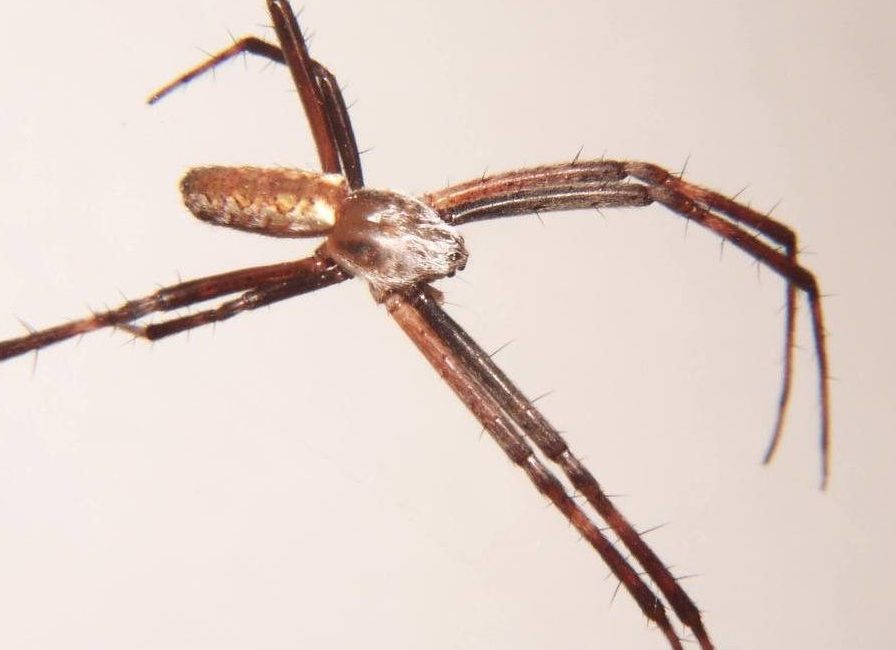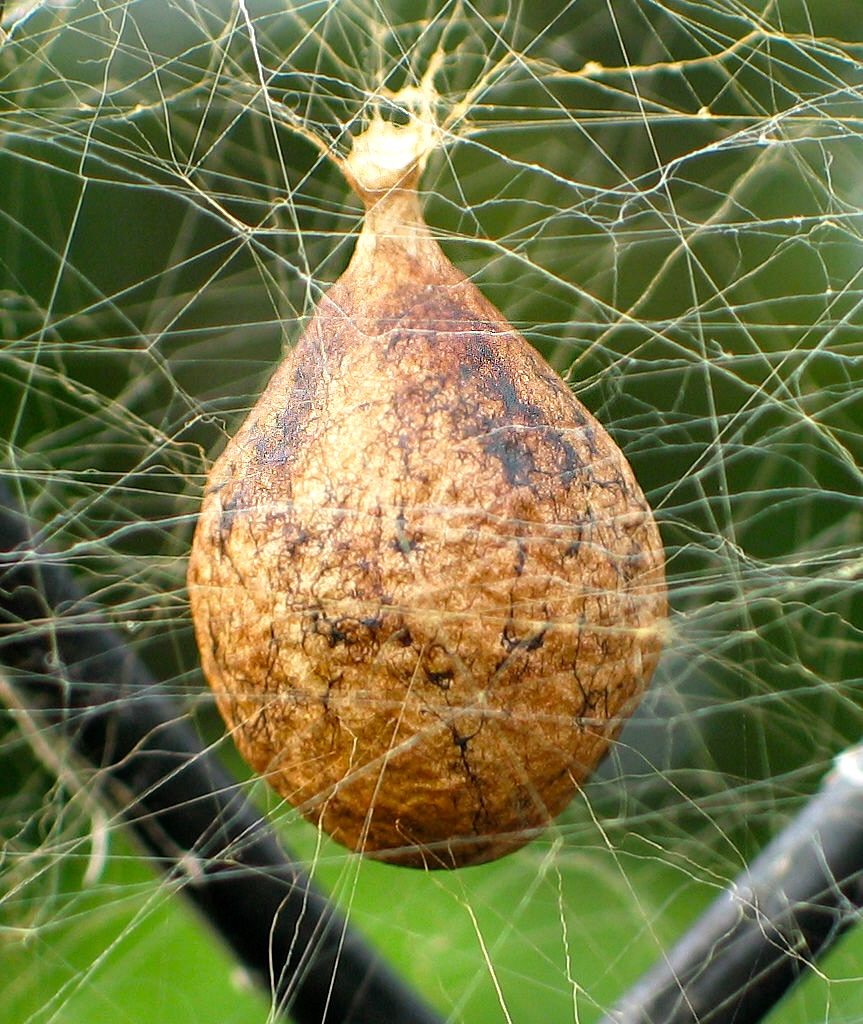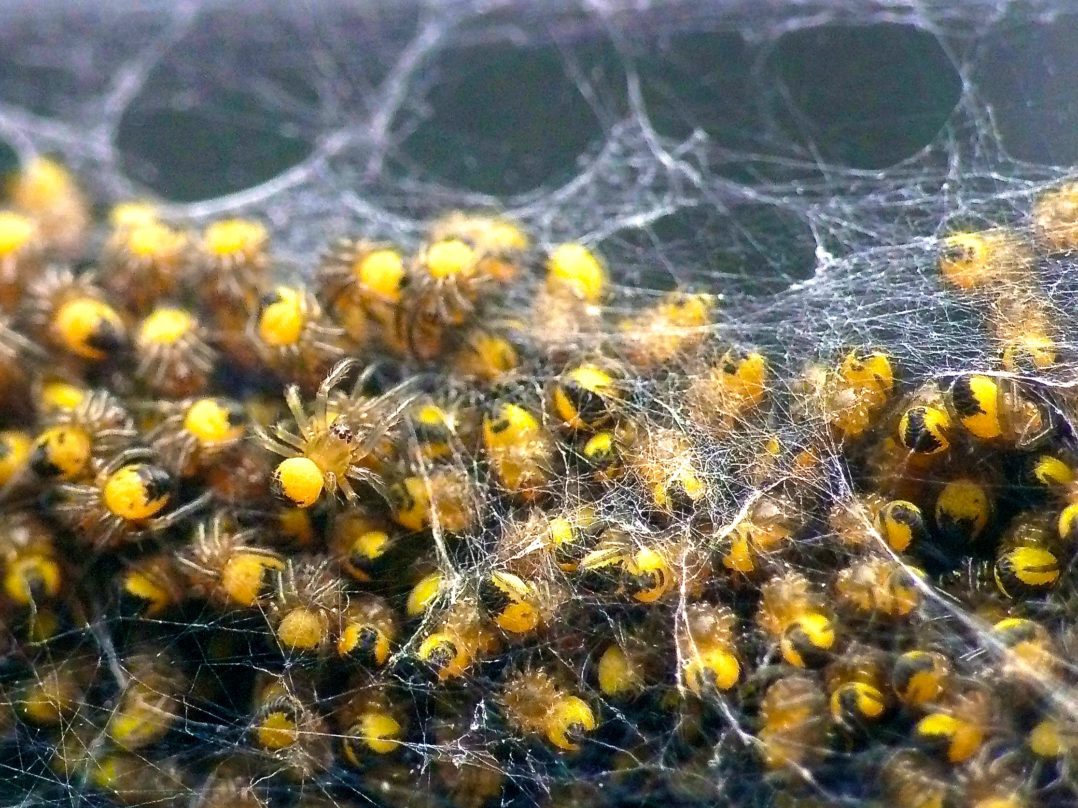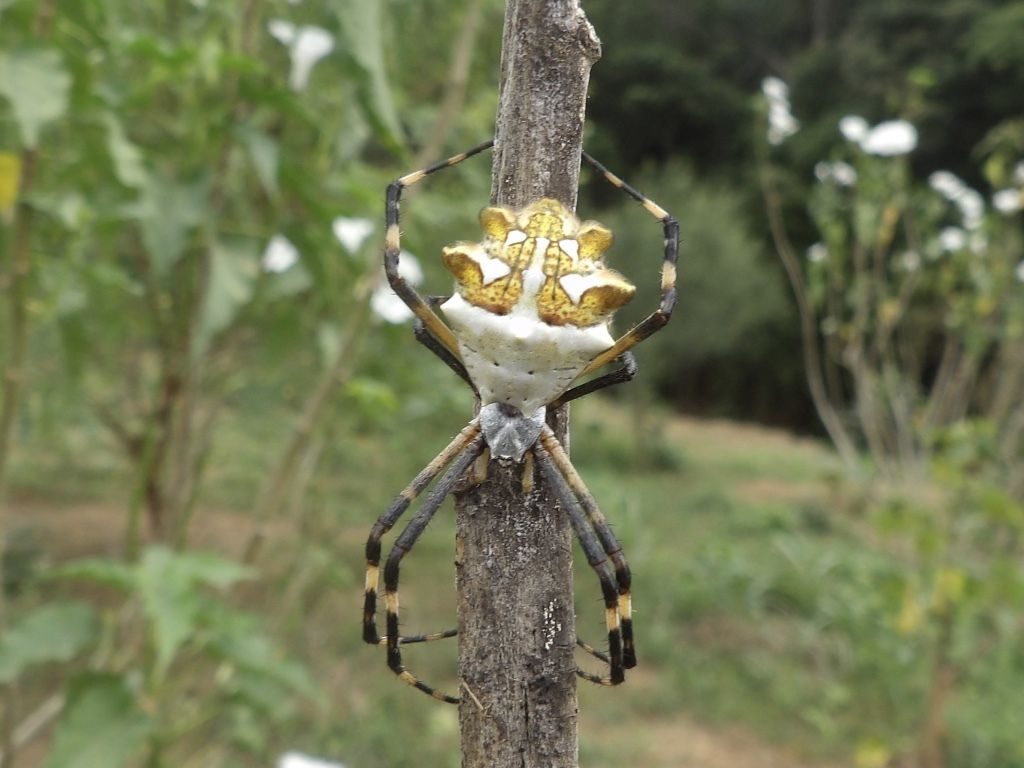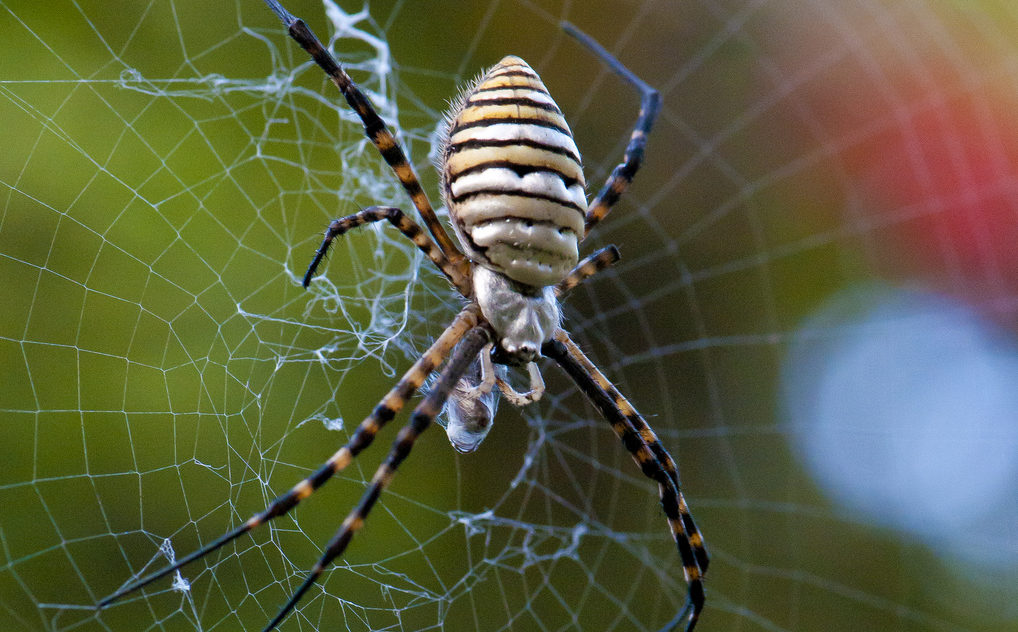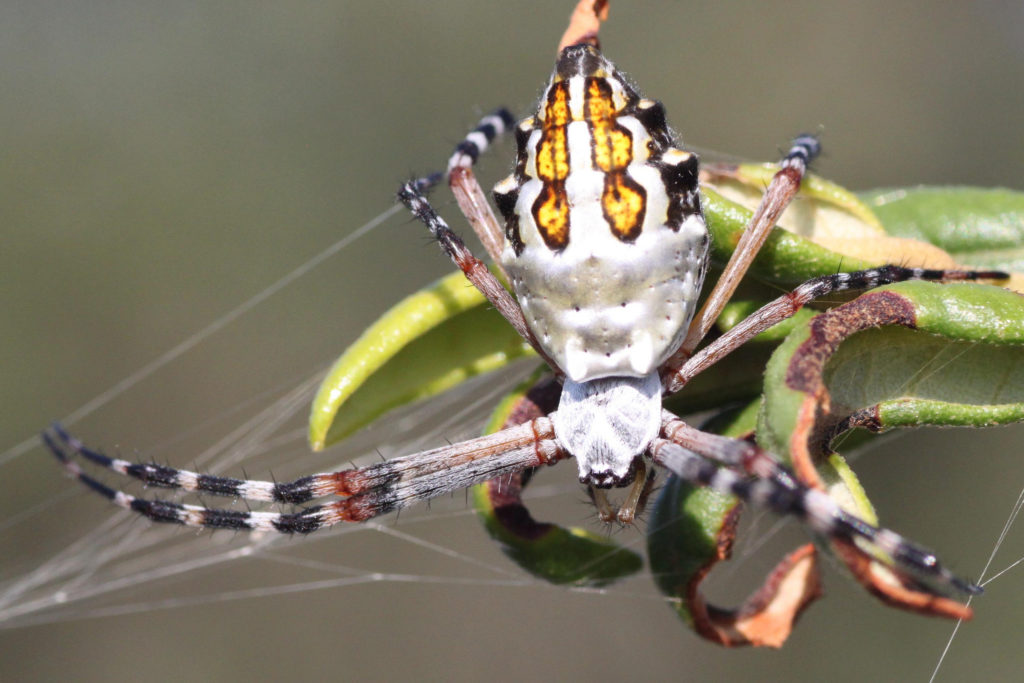Black-and-yellow Garden Spiders are scary-big, and their webs are, too. The odd thing is we usually don’t see them until the fall. And, then suddenly, there’s this beautiful giant spider in a web the size of a serving platter right in front of us in our garden or even on the deck! It appeared virtually overnight. That’s because it’s been following a plan. It actually has been around all summer, but smaller and weaker, less able to defend itself from predators, so it stayed in hiding. It could see you, but you couldn’t see it. By fall, though, it’s time to take a bow; it’s full-size and ready to take on all comers.
You may know these spiders by another name in your area: Corn Spiders, Zipper Spiders, Writing Spiders, Golden Garden Spiders, Yellow Spiders, or McKinley Spiders. Their Latin name is Argiope aurantia (AR-gee [or jee]-OH-pee; ahr-RAN-cha). They belong to the order Araneae (ar-RAIN-ee-eye or ee) and the family Araneidae (AIR-uh-NEE-uh-die or ee). A fossil found in China of an extinct species, Argiope furva, reveals that their genus dates back to at least the Miocene Epoch, 23.03 to 5.3 million years ago. Because their web is so distinctive—large, spiral, and wheel-shaped—Argiopes are in a group called orb-weavers. Many of them are brightly colored.
Black-and-yellow Garden Spiders are uncommon in parts of the Rocky Mountains, most of Nevada, half of Utah, and sections of Idaho, Wyoming, Oregon, and California where there’s little vegetation. But, otherwise, they’re found throughout most of the continental United States, Hawaii, southern Canada, Mexico, and Central America.
In addition to the Black-and-yellow Garden Spider, three other Argiope species inhabit North America. (You’ll see them at the bottom of this page.) Around the world, there are 3,500 species—all are rather large, have colorful abdomens, and construct webs made of white silk.
Physical description
The Black-and-yellow Garden Spiders that catch our attention are all females. As with many other spider species, the males are tiny by comparison. Not including their legs, males are only 0.20–0.35 inches (5–9 mm) long, while females are 0.75–1.10 inches (19–28 mm). Males are also pale in comparison to the colorful females.
The Black-and-yellow Garden Spider’s Latin name, Argiope aurantia, means “gilded silver-face.” That’s fitting, as most (not all) have silvery hairs covering the front part of their body, along with a yellow (gilded) and black abdominal pattern. Their eight legs are black with red or yellow markings. Each foot has three claws, whereas most spiders have two. Their extra claw is used to help handle threads as they spin their webs. Their bite is venomous and immobilizes their prey (harmless to humans, though).
They have eight eyes, but their vision is poor. So, instead of using eyesight, they sense vibration and air currents to tell them about their environment. Spiders don’t have ears, but recent research1 involving a family of spiders called “jumping spiders” has shown that the hairs on their legs are so sensitive they can detect sound from several feet away—it’s likely that other spiders, perhaps Argiopes, too, can “hear” in this way. They also can smell and taste through sensory hairs on their legs and other parts of their body.
Life cycle
A male’s life is spent roaming around until he finds a female. When he does, he typically constructs a web nearby and begins to court her by plucking the strings of her web, which she can detect. (Males usually have a drop line ready when they approach females—occasionally, a hungry female will eat her mate!)
After mating, the female lays her eggs on a sheet of silk and covers them with a layer of silk topped by another layer of paper-like silk. Then, she bundles them into a roundish ball, which she places in her web, off to the side or sometimes near the center. She’ll produce up to three, rarely four, egg sacs during the summer. Up to one inch (25 mm) in diameter, each sac may hold from 300 to more than a thousand eggs, and she carefully watches them.
The spiderlings hatch in late summer or fall and look like tiny adults, except they lack mature reproductive organs. They stay within their egg sac, in a state of dormancy, through the winter. Then come spring, the spiderlings, who look just like their parents, emerge and grow ever larger through the summer, shedding (molting) their exoskeleton several times to make way for their growing bodies. By late summer and fall, they’re a year old, fully grown, and sexually mature. That’s when we begin to notice the females. They’ll mate, lay eggs, and the cycle starts again.
Webs
A female’s large, distinctive web may be up to 2 feet (60 cm) in diameter. In the center of it, she lays a dense, silk zigzag pattern known as a stabilimentum. There are other species of spiders that do this, too. It isn’t understood why, but there are several theories:
Perhaps the stabilimentum helps to camouflage the spiders as they sit in the center. Or it makes the web appear larger. Maybe it’s used to regulate excess silk, attract males to females, or attract prey. What if its highly visible strands prevent birds from flying through and destroying the web? No one is certain. Perhaps it’s all of that.
She hangs head down in the center to await prey, holding her legs together in pairs, so it often looks like she has only four legs instead of eight. She might also choose to lurk at the edge of her web.
Lifespan
In temperate climates, the lifespan of female Black-and-yellow Garden Spiders begins in the fall and lasts until the first hard frost of the following year. Males die within their first year, after mating. In warmer climates, females may live for several years.
No threat!
Black-and-yellow Garden Spiders aren’t dangerous to humans. They aren’t aggressive and don’t bite unless severely provoked, such as repeatedly poking at them. They’re predators of insects, including those we consider pests, so they’re beneficial to have around. Leave them alone, and they’ll return the favor while helping to control insect populations. If forced to bite, their venom is harmless to humans, and the pain is comparable to a bee’s sting.
Prey and predators
For food, Black-and-yellow Garden Spiders feed on virtually any insect, usually a flying one, that gets caught in their web. The spiders themselves are prey for birds, lizards, wasps, shrews, and others. They defend themselves by first vigorously vibrating their web—this may make it harder for predators to home in on them. If that fails, they drop to the ground and hide. Their egg sacs are also preyed on.
Other Argiope species in the U.S.
Here are the other three Argiope species found in North America.
1 Merrit Kennedy, “A Spider Across The Room Can ‘Hear’ You,” NPR.org, October 14, 2016.
All about spiders, Part 1
All about spiders, Part 2
Native plants for pollinators, birds
For more about Black and Yellow Garden Spiders – Wikipedia



